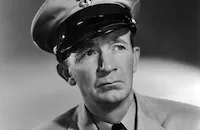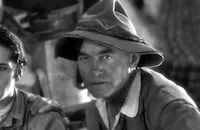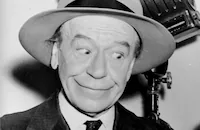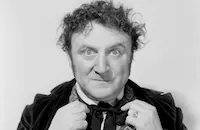Barbary Coast

Brief Synopsis
Cast & Crew
Howard Hawks
Miriam Hopkins
Edward G. Robinson
Joel Mccrea
Walter Brennan
Frank Craven
Film Details
Technical Specs

Synopsis
Beautiful Mary Rutledge arrives in San Francisco in the 1850's to marry Dan Morgan, only to discover that Morgan has died mysteriously after loosing his fortune to Louis Chamalis, a powerful saloon owner. Mary goes to work for Chamalis as a roulette operator and although he is in love with "Swan," as she is now known, she does not return his affection. She feels emotionally dead until one afternoon when, caught in a rainstorm while riding, she meets and falls in love with Jim Carmichael, an erudite Easterner who has come West to earn his fortune. Thinking that she will never see Jim again, Mary pretends to be a lady. A short time later, when Jim wanders into the Bella Donna saloon and sees her, he gambles away all of his money at her wheel. Later, Chamalis hires Jim, ignorant of the love between him and Mary. Chamalis' power in San Francisco is by now eroding under the pressure of the vigilantes who know that he and his henchman, Knuckles Jacoby, have murdered two Scottish miners as well as Colonel Marcus Aurelius Cobb, a crusading newspaperman who had befriended Mary. Knuckles is hanged by the vigilantes. Meanwhile, Mary lets Jim win back his money and urges him to leave. Admitting their love for each other, they set out in a rowboat in the fog to reach a boat bound for the East. When Jim is shot by one of Chamalis' men, Mary promises to love Chamalis in the same way that she loves Jim if he will only let Jim go. Chamalis agrees, but knowing that he is finished, he faces the vigilantes alone, letting Jim and Mary go off together.

Director

Howard Hawks
Cast

Miriam Hopkins

Edward G. Robinson

Joel Mccrea

Walter Brennan

Frank Craven

Brian Donlevy
Clyde Cook

Harry Carey
Matt Mchugh

Donald Meek
Rollo Lloyd

J. M. Kerrigan
Roger Gray
Otto Hoffman
Anders Von Haden
Jules Cowles
Cyril Thornton

David Niven

Herman Bing
Crew

Videos
Movie Clip



Trailer
Film Details
Technical Specs

Award Nominations
Best Cinematography
Articles
Barbary Coast
Set in San Francisco during the Gold Rush of the 1890s, Barbary Coast follows the wild and wooly exploits of Luis Chamalis (Edward G. Robinson), a crooked casino owner who falls hard for Mary Rutledge (Miriam Hopkins), a woman from the east who finds herself stranded in California. Soon enough, Mary is running the roulette wheel at Luis' casino, but things get complicated when she connects with Jim Carmichael (Joel McCrea) an upstanding gold prospector. Robinson chews up the scenery in grand style, but the supporting cast is also a lot of fun in this standard-issue 1930s potboiler.
Hawks fell into directing Barbary Coast almost by accident. He'd been set to helm a doomed picture called Sutter's Gold at Paramount when the displaced Russian genius, Sergei Eisenstein, backed out of the production. Hawks couldn't make any headway either, so he abandoned it and happily agreed to help out his old buddies, writers Ben Hecht and Charles MacArthur, who were attempting to produce their own pictures back in New York City. Hawks was more or less just guiding the two writers while they tried to shoot their first film. But he was also pleased to be on the opposite coast from his long-suffering wife, since that made it easier to chase actresses and showgirls.
Samuel Goldwyn eventually ended the vacation, more or less, when he recruited Hawks to adapt Herbert Asbury's book, The Barbary Coast: An Informal History of the San Francisco Underworld. (Asbury also wrote "The Gangs of New York," which Martin Scorsese shot some 60 years later.) After several failed attempts to wrestle the tome into a serviceable screenplay crews of writers regularly entered and exited the project Hawks put in a call to Hecht and MacArthur, whose dreams of becoming big-time producers on the east coast were collapsing.
Perhaps the highlight of the arduous Barbary Coast writing process was when Hawks was interrupted by a knock at his Nyack, New York front door, opened it, and saw Tallulah Bankhead standing on the porch. While Hecht, MacArthur, and other collaborators pretended not to watch from the next room, Bankhead shouted, "Damn you!" smacked Hawks in the head, and stomped off. No one had the guts to ask Hawks what the assault was all about, so they just kept on writing!
After the team completed five separate drafts of the screenplay, Barbary Coast was finally ready to go before the cameras. The shoot wasn't a particularly happy occasion. Robinson detested his co-star, Hopkins, and the cast was divided into loudly argumentative political factions, so there was always tension in the air. But Hawks pulled things together the best he could and made a lifelong friend of Walter Brennan in the process.
Hawks started laughing the moment the gangly, prematurely elderly Brennan was brought in to audition for the role of a character known as Old Atrocity. When he calmed down enough for Brennan to recite his lines, Brennan asked, rather cryptically, "With or without?" Upon further questioning, Hawks realized he was being asked whether Brennan should play the character with or without his false teeth! The line reading was promptly dropped, and Hawks hired the fledgling actor on the spot. The two men would go on to work together five more times, with Brennan winning an Oscar® for their next picture, an otherwise forgotten feature called Come and Get It (1936).
Director: Howard Hawks
Producer: Samuel Goldwyn
Screenplay: Ben Hecht, Charles MacArthur
Editor: Edward Curtiss
Cinematographer: Ray June
Music: Alfred Newman
Art Direction: Richard Day
Sound: Frank Maher
Costumes: Omar Kiam
Cast: Edward G. Robinson (Luis Chamalis), Miriam Hopkins (Mary "Swan" Rutledge), Joel McCrea (Jim Carmichael), Walter Brennan ("Old Atrocity"), Frank Craven Col. Marcus Aurelius Cobb), Brian Donlevy (Knuckles Jacoby), Clyde Cook (Oakie), Harry Carey (Jed Slocum).
B&W-91m.
by Paul Tatara

Barbary Coast
Quotes
I'm running this town and there's only one way to run it: my way!- Chamalis
Trivia
Notes
According to pre-production news items, this film was to have begun production in the Spring or Summer of 1934, starring Gary Cooper and Gloria Swanson, under William Wellman's direction. In May 1934, it was announced that the picture was to star Cooper and Anna Sten, but, a January 1935 news item in Daily Variety noted that producer Samuel Goldwyn had decided to shelve the picture because he thought it could not pass censors. Because Cooper had, by 1935, completed a one picture deal with Goldwyn and returned to his home studio, Paramount, he had to be replaced in the lead, and Goldwyn no longer wanted Sten for the female lead, new leads were needed. Miriam Hopkins was signed for the role of "Mary Rutledge" in January 1935. Some modern sources state that William Wyler was actually the film's first director and that filming began in mid-1934 with Cooper and Sten; however, contemporary information makes no mention of Wyler, who was working at Universal at the time, and news items refute the implication that filming actually took place in 1934 under any director. Wyler's first work for Goldwyn was the 1936 release These Three (see below). Other contemporary news items noted that Goldwyn had signed actor Paul Kelly for a role in the picture when Cooper and Sten were cast as the leads, and that writers Dwight Taylor and Courtenay Terrett were hired to write the script at various times in mid-1934. Kelly was not in the film; it is possible that he was to have played the role of Louis Chamalis which was taken over by Edward G. Robinson. Neither Taylor not Terrett were mentioned in contemporary sources after 1934 and the extent of their contributions to the final screenplay has not been determined.
A Daily Variety news item on March 20, 1935 noted that screenwriters Ben Hecht and Charles MacArthur decided to do this film for Goldwyn because the pictures they had produced for Paramount had failed at the box office. This was the first of four films which Hopkins made for Goldwyn, all of which co-starred Joel McCrea. It was also the first film that Howard Hawks directed for Goldwyn. According to modern sources, this was David Niven's first American film, however, he appeared in the Paramount film Without Regret (see below), released prior to Barbary Coast, on August 23, 1935. Production on Without Regret began on June 18, 1935, one day after production began on Barbary Coast. It is possible that Niven's role in Barbary Coast was completed before his role in Without Regret. This also marked Walter Brennan's first appearance in a Goldwyn film. Modern sources include the following additional cast members: Wong Chung (Ah Wing), Russ Powell (Sheriff), Fredrik Vogeding (Ship's Captain), Dave Wengren, Clarence Wertz, Harry Semels, Theodore Lorch, George Magrill, Jack Pennick, Nina Campana, Constantine Romanoff, George Lloyd, Jimmie Dime, Leo Willis, John Ince, Frank Rice, Patricia Farley, Hank Mann, Blackie Whiteford, Edward Gargan, Monte Montague, Harry Holman, Ethel Wales, Kit Guard, Heinie Conklin, Tom London, and Jim Thorpe. According to modern sources, the film was re-issued in 1960 under the title Port of Wickedness.

Miscellaneous Notes
Released in United States Fall September 27, 1935
Released in USA on video.
Released in United States Fall September 27, 1935














